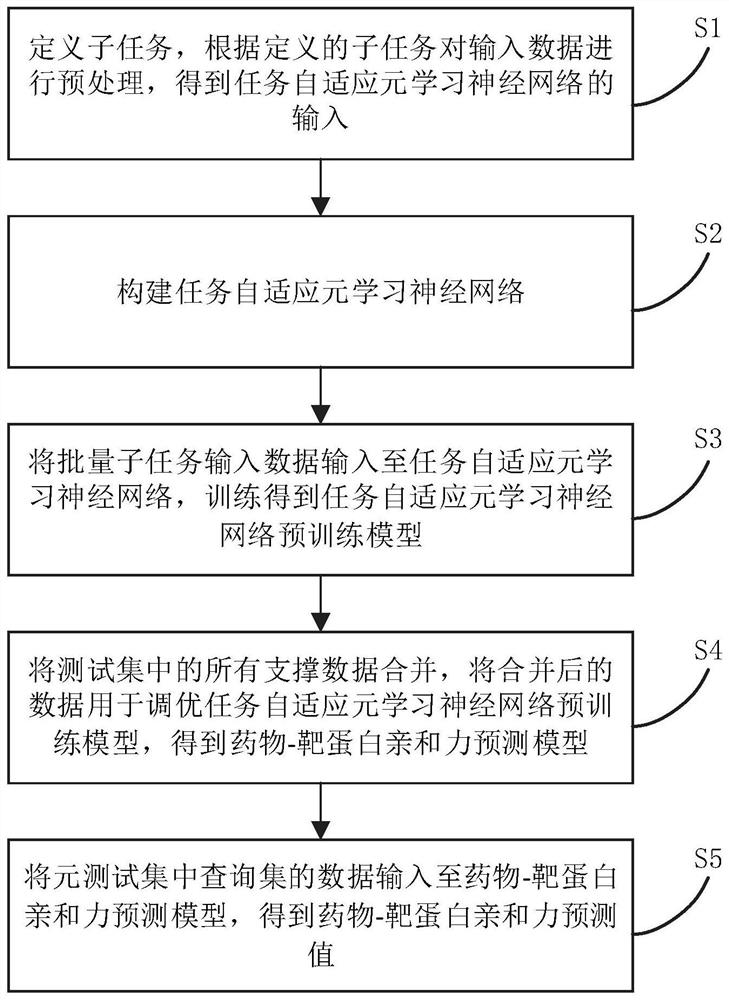Drug-target protein affinity prediction method and system
A prediction method and target protein technology, applied in proteomics, biostatistics, bioinformatics, etc., can solve problems such as task inequality, improve accuracy, solve cold start problems, and improve task adaptability Effect
- Summary
- Abstract
- Description
- Claims
- Application Information
AI Technical Summary
Problems solved by technology
Method used
Image
Examples
Embodiment 1
[0054] Embodiment 1 provides a drug-target protein affinity prediction system, which includes:
[0055] The extraction module is used to encode the medicinal chemical molecule and the target protein molecule in the drug-target protein pair to be detected, respectively, to obtain the drug input representation and the target protein input representation;
[0056] The prediction module is used to use the drug-target protein affinity prediction model to process the drug input representation and the target protein input representation to obtain a drug-target protein affinity prediction value; wherein, the drug-target protein affinity prediction model utilizes a training set After training, the training set includes a plurality of drug-target protein pairs and a label marking the true value of the affinity between the drug and the target protein in each drug-target protein pair.
[0057] In Example 1, a drug-target protein affinity prediction method was implemented using the above-m...
Embodiment 2
[0077] Meta-learning, also known as learning how to learn, includes metric-based learning methods, model-based methods, and optimization-based methods. Meta-learning aims to mine the similarities between different tasks, and its significant advantage is that it can be quickly transferred to new tasks. Therefore, meta-learning provides a new way to solve the cold-start problem in drug-target protein affinity prediction.
[0078] Based on this, in this embodiment 2, a drug-target protein affinity prediction method based on task-adaptive meta-learning neural network is proposed. Task inequality, thereby improving the ability of the model's task adaptability and generalization. The problem of drug cold start, target protein cold start, and drug-target protein cold start can be solved simultaneously in the same model, and the accuracy of drug-target protein affinity prediction can be improved.
[0079] like figure 1 As shown, the drug-target protein affinity prediction method ba...
Embodiment 3
[0150] Embodiment 3 of the present invention provides a non-transitory computer-readable storage medium. The non-transitory computer-readable storage medium is used to store computer instructions. When the computer instructions are executed by a processor, the drug- A method for predicting target protein affinity, the method comprising:
[0151] The medicinal chemical molecule and the target protein molecule in the drug-target protein pair to be detected are respectively coded to obtain the drug input representation and the target protein input representation;
[0152] The drug-target protein affinity prediction model is used to process the drug input representation and the target protein input representation to obtain a drug-target protein affinity prediction value; wherein, the drug-target protein affinity prediction model is trained using a training set, and the The training set includes multiple drug-target protein pairs and a label annotating the true value of the affinit...
PUM
 Login to View More
Login to View More Abstract
Description
Claims
Application Information
 Login to View More
Login to View More - R&D
- Intellectual Property
- Life Sciences
- Materials
- Tech Scout
- Unparalleled Data Quality
- Higher Quality Content
- 60% Fewer Hallucinations
Browse by: Latest US Patents, China's latest patents, Technical Efficacy Thesaurus, Application Domain, Technology Topic, Popular Technical Reports.
© 2025 PatSnap. All rights reserved.Legal|Privacy policy|Modern Slavery Act Transparency Statement|Sitemap|About US| Contact US: help@patsnap.com



